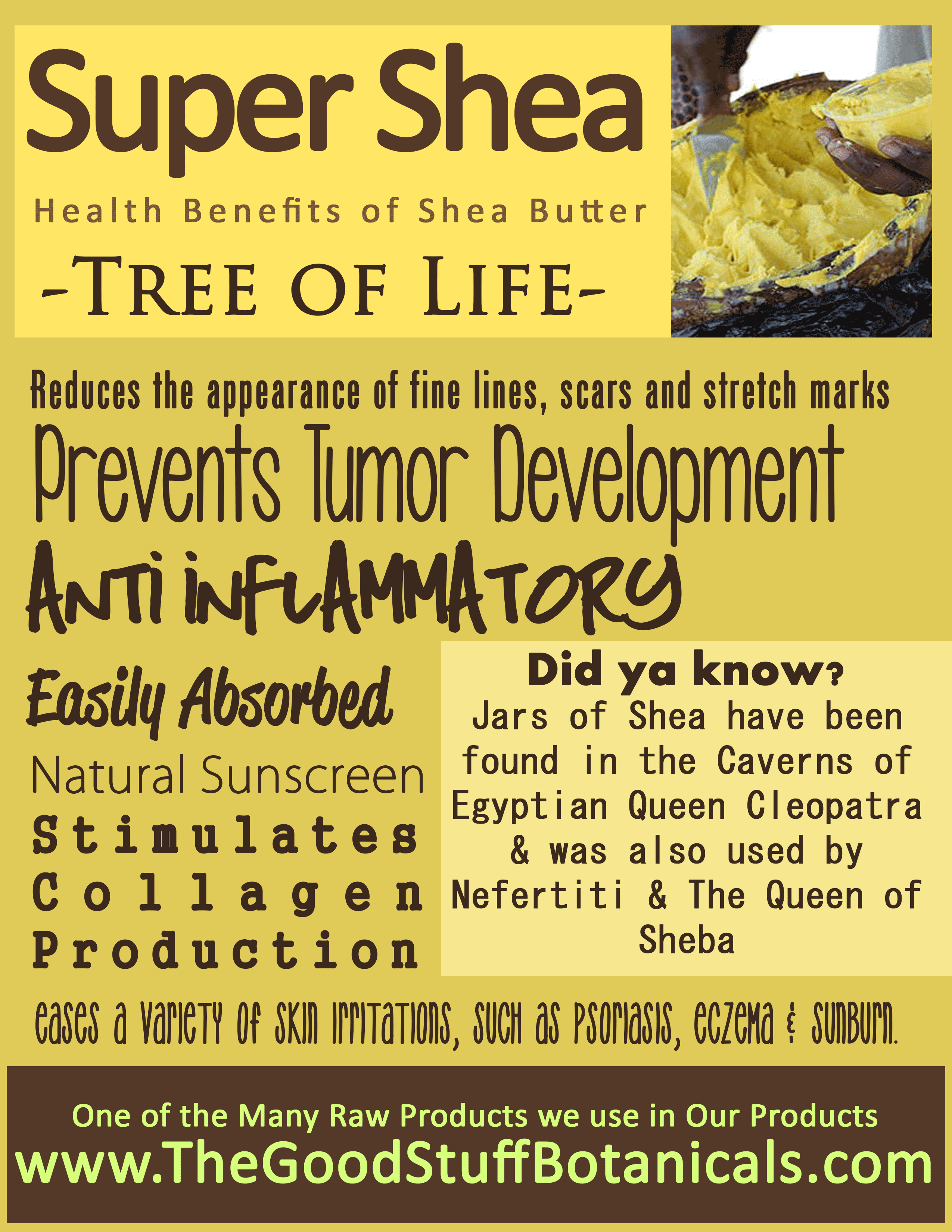Shea Butter Skin Benefits
Benefits of Shea Butter
The fat of the nut of the African Shea tree (Vitellaria paradoxa) is the source of Shea butter.
The traditional use of the butter is to reduce the appearance of fine lines, scars and stretch marks,
and to ease a variety of skin irritations, such as psoriasis, eczema and sunburn. Part of the reason
it does this is because stimulates collagen production. Shea butter is ideal for the topical application
of cosmetic and medicinal formulas, because it melts on contact and is readily absorbed into the
skin, without leaving a greasy residue.
Healing Qualities
The healing qualities of Shea butter are due to the presence of several fatty acids and plant sterols, namely oleic, stearic, palmitic and linolenic acids. These oil-soluble components are nonsaponifiable, meaning they do not undergo saponification, or convert to soap, when introduced to an alkali. Shea butter possesses a significantly greater nonsaponifiable fraction than most other nut oils and fats, which lends the substance to greater healing potential for the skin.
Anti-Inflammatory Properties
Shea butter contains several derivatives of cinnamic acid, a compound common to cinnamon and balsam trees. In the May 2010 issue of the "Journal of Oleo Science," Toshihiro Akihisa and fellow researchers published the results of a study that investigated the effects of four triterpene acids and four triterpene cinnamates isolated from Shea butter on tissue swelling in mouse skin. The scientists reported that Shea butter not only demonstrated anti-inflammatory benefits, but one compound, lupeolcinnamate, also prevented tumor development in a carcinogenesis test, a procedure in which cancercells are literally "grown" in a culture dish. The biological activities of triterpene acetate and cinnamate esters, together with the exceptionally high levels of these triterpenes in shea fat, indicate that shea nuts and shea fat (shea butter) constitute a significant source of anti-inflammatory and anti-tumor promoting compounds.
Antioxidant Content
Shea butter contains vitamins A and E, as well as catechins, plant antioxidants also found in green tea. While it is unclear how well vitamins A and E in raw Shea butter are absorbed, there is evidence to suggest that cinnamic acid esters in Shea fat help to prevent skin damage from ultraviolet radiation.
Other Uses
Shea butter softens and conditions leather and wood, so musicians use it to improve the flexibility of leather tuning straps, and the pitch and timbre of animal skin drums and other percussion instruments. Africans use Shea butter in cooking. In other parts of the world, manufacturers add Shea butter to margarine.
Precautions
Shea butter is available in different grades, which depend on the extraction method. For best results, unrefined Shea butter, or grade A, is preferred. If you have a known allergy to other tree nuts, you may experience a reaction to Shea butter. Consult your physician or allergist before using this product, if this is the case. We use only pure, unfrined, raw shea butter straight from Ghana, Africa.
Reference: References
United Nations Development Program: Shea Butter Scoping Paper
"Journal of Oleo Science"; Anti-Inflammatory and Chemopreventive Effects of Triterpene Cinnamates and Acetates from Shea Fat; T. Akihisa et al.; 2010
"Journal of Photochemistry and Photobiology"; Caffeic Acid Modulates Ultraviolet Radiation-B Induced Oxidative Damage in Human Blood Lymphocytes; N. R. Prasad et al.; June 2009
